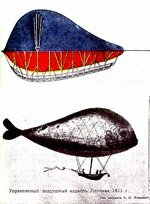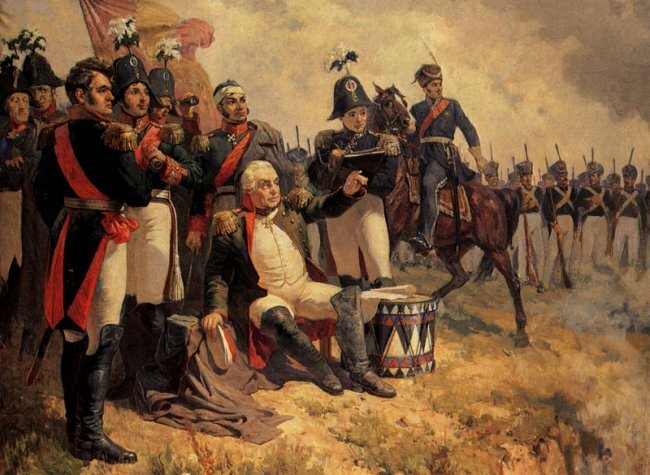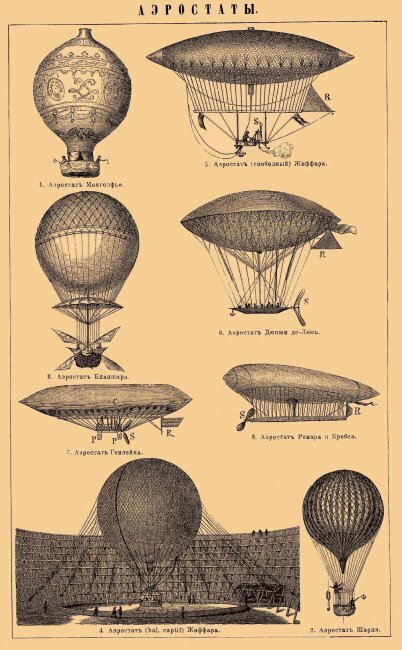Kutuzov's secret weapon
Extraordinary Adventures of the Inventor Franz Leppich in Russia
On this day, Pierre, in order to have a good time, went to the village of Vorontsovo to watch the big balloon that Leppich had built for the death of the enemy, and the trial balloon, which was to be launched tomorrow. The ball was not yet ready; but, as Pierre learned, it was built at the sovereign’s will.
The sovereign wrote the following to Count Rastopchin about this ball: “Leppih will be ready just now, make up the crew for his boat of loyal and intelligent people and send a courier to General Kutuzov to warn him. I told him about it. Inspire, please, Leppich to He paid close attention to the place where he would go down for the first time, so as not to be mistaken and not fall into the hands of the enemy. It is necessary that he should understand his movements with the movements of the commander in chief.
It is not known what the course of the Napoleonic Wars would be if the Emperor of France led them using underwater fleet and air force. Such an assumption is not fiction. Until 1804, in France, the future creator of the ship Robert Fulton tested the Nautilus submarine. Napoleon abandoned the project, saying that "such a method of acting against the enemy is dishonest," and the British lured the engineer. Around 1811, the German mechanic Franz Leppich proposed to Napoleon to equip the army with a controlled combat balloon, capable of not only conducting reconnaissance, but also hitting enemy troops from above.
Napoleon also refused the tempting offer of Leppich - apparently, he knew about the similar (unsuccessful) project of the French General Meunier, proposed as early as 1783 year. However, fearing even Leppich’s attempts to make such an offer to opponents, Napoleon gave the order to detain Leppih and deliver it to Paris. It was not possible to detain Leppih: he managed to escape in one of the numerous German states. In the spring of 1812, he turned to the Russian envoy in Stuttgart, and through him to Emperor Alexander I with a proposal to build a controlled balloon for Russia. Within three months, Leppih developed his plans, the Russian army can be supplied with fifty aircraft, each of which will have a crew of forty people and 12 000 pounds of combat cargo, primarily boxes of gunpowder. These boxes, dropped from a height, could explode "overthrow entire squadrons" with their explosions.
Alexander, who was preparing for the inevitable clash with Napoleon, decided to try to implement the project Leppich. Immediately followed by a decision to classify all the information on the development of a balloon. The best keepers of secrecy were the officers of the Courier Corps. Of these, a special group was created headed by Lieutenant-Colonel Nikolai Kastorsky1, who then headed the Courier Corps. In addition, it was Kastorsky who was entrusted with the control over the transfer of all the money coming from Russia to the construction of the balloon.
But first it was necessary to take out Leppih from Europe under the control of Napoleon, and the same roads that the Napoleonic army advanced to the borders of Russia in the spring of 1812. Courage lieutenant Adolf Jordan changed his name to the Courland name Fechter, and his uniform uniform on civilian clothes. In May, the Feuhner kurlander and the next Dr. Schmidt with him got out of Germany, crossed Poland, the western provinces of Russia, and drove into Moscow. Only on arrival (May 14) did the courier lieutenant hand over to the Moscow civil governor Obreskov the command of the emperor regarding the maintenance of the Leppich project.
27 May 1812, the Obreskov Year, informed the Emperor Alexander that the mechanic Leppih and his ensign Ensign Jordan had arrived in Moscow under other names, that "all movements in this case are carried out with great care and ... the real deal will remain in complete secrecy until the very end" the works are found in a convenient place six miles from the capital, and for them to begin 8000 rubles are sent.
 Leppih was placed in the Voronovo estate, and it was announced to be curious that agricultural machines or gun carriages would be built here ...
Leppih was placed in the Voronovo estate, and it was announced to be curious that agricultural machines or gun carriages would be built here ...The curiosity of Muscovites and residents of suburban villages grew every day. Entire families went to the mysterious secluded cottage, but did not see anything except a high fence. And behind the fence, 14 joiners, 8 locksmiths, 3 tailors, 24 seamstresses, 2 washerwomen and a few maintenance staff worked. After a few weeks, the number of workers was increased to 100 people.
Workers tried to implement several technological processes at the same time: they created a shell, fastened the frame and assembled the gondola. The most difficult and dangerous process was filling the shell with hydrogen: this explosive gas was moving along the sleeves of the many barrels in which a chemical reaction was going on continuously (sulfuric acid was corroding iron). The construction took more and more materials, more and more government funds, and new technological difficulties pushed aside and pushed back the time of the first balloon rise.
At one of the stages, Leppih asked for skilled workers from Germany or Austria. Risking his life (already a war!), Feldjeger Vinberg managed to find in Austria (at that time an ally of Napoleon) and bring to Moscow those specialists that Leppih needed. Alas, these workers could not change the course of events: the aerostat filled with hydrogen could not get off the ground: the taffeta envelope did not hold the gas well.
Then, during the tests, metal springs burst, through which the crew could control the balloon. It took high-quality tool steel, which was not produced in Russia. Lieutenant Colonel Kastorsky gave the order to the couriers quickly to find and deliver all the necessary materials to Leppih. The couriers found and delivered top-quality English steel, but the matter did not get off the ground. Especially since heavy rains started and the process of hydrogen production was disturbed.
Meanwhile, Muscovites already knew about the ball, and in crowds went to Vorontsov on excursions for a reason that Madame de Stael noticed at that time: "In Russia, everything is a mystery and nothing is a secret." By the way, and Leo Tolstoy, in “War and Peace,” Pierre went “for fun” to look at a strange ball. Learned about the project and Napoleon. At first, as Kolenkurk recalled, "the emperor was told ... about an incendiary balloon, over which a certain Englishman or Dutchman named Schmidt had been working under the cover of secrecy for a long time. This ball was said to have destroyed the French army, bringing disorder and destruction into its ranks . Then clarifications followed, about which Count Ségur told in his memoirs: they say, on the orders of Alexander himself not far from Moscow, under the supervision of German pyrotechnics, a monstrous ball is built; The main purpose of this winged aerostat is to hover over the French army, find its commander and destroy it, bringing down the whole rain of fire and metal from above.
MI Kutuzov had some hopes for the use of a combat aerostat in the battle of Borodino. After all, in the middle of August Leppih promised to fly on his staff directly to the headquarters of the Russian army. He even managed to launch a “small ball”, which didn’t raise two people, though. 22 August, on the eve of the Battle of Borodino, Kutuzov wrote to Governor-General Rostopchin: "The emperor told me about a balloon that is secretly being prepared near Moscow. Can I use it, please tell me how to use it more conveniently." Alas, Rostopchin himself lost faith in the Leppih project (in his memoirs he would call mechanics a scoundrel in general), and decided to use it at least to maintain the spirit of Muscovites. Then, 22 of August, he told the townspeople not to be frightened if a balloon flew over the city, because it is not “from the villain” (that is, Napoleon), but, on the contrary,weapon"made" to his harm and destruction. Similarly, Emperor Alexander was disappointed with the project, but spoke with Arakcheyev about his ideological value: "For the people, such measures are necessary in certain cases; such fabrications soothe a credulous crowd, at least for a short time, when there are no other means to avert misfortune. "
Napoleon was already approaching Moscow, and all attempts to take off remained unsuccessful, as the spring wings constantly broke. There was a danger of losing even a little hope for the project. By order of Rostopchin, Leppih turned down the work, loaded the aerostat property on the 130 carriage and moved towards Nizhny Novgorod. The courier service provided evacuation, which was charged with paying for postal runs with state money. The feldjeger (it was Lieutenant Stoss) encouraged Leppih last time: he brought an order from Arakcheyev, who was then in charge of the affairs of supplies and reserves under the emperor (with the right to proclaim the Highest Commandments). It said: "Send ... Mr. Leppich, all the necessary people and things to St. Petersburg." When Leppih arrived in St. Petersburg, he was already awaited by the workshop in Oranienbaum: its temporary commandant, courier Vinberg, cleared the hospital premises from outside property.
Meanwhile, Napoleon, who entered Moscow on September 3, has already ordered to find the “Dr. Schmidt’s” workshop. A detachment of General Lauer found a place to build the ball, but it was already ashes. Everything the French saw was recorded in detail under the heading "A detailed description of various things found near the village of Vorontsovo, near Moscow, belonging to a balloon or an infernal machine ... which supposedly served to exterminate the French army." And they saw the "boat", "which was supposed to be hung from the ball, but which was burned the day before the French troops entered Moscow ... at a distance of about 100 steps from the building, there were a lot of screws, nuts, nails, hooks, springs and a lot of iron shells (parts. - Auth.) of every kind. Nearby is a large wooden shield in the shape of a ball, which, it’s true, was used for the sample. In the two rooms of the mentioned building there are also 180 large grains of vitriol; and in front of the house, stands 70 barrels and 6 New vats of extraordinary build. In the house itself there are carpentry and locksmith shops and some tools necessary for it. They are noted in a small white house, standing not far away and in front of a large one, traces of scattered and trampled powder ... ".
According to one of the rumors, torches or even "rockets" were found in the basements of the workshop of the "German pyrotechnics" for arson of Moscow. Therefore, a trial of the "criminals" caught near the dacha soon took place, and 10 people from among those arrested were shot.
And Leppih was still trying to raise his brainchild in the air above Oranienbaum. By the fall of 1813, the balloon of Leppich several times climbed 5-6 to fathoms above the ground, but could not fly, much less fly against the wind. Alexander lost patience and ordered the Artillery Committee to draw a conclusion on the experiments of Leppich. Leppih, who understood that this was the end of a dream, how he could, shied away from considering his experiments on the military scientific committee, especially since 320 thousand rubles of government money were spent on them!
In the end, the unfortunate inventor went to Germany. In Russia, rumors began to circulate that Leppich began to advertise his idea among the merchants, saying that a balloon could transport their products through the air, downwind and against the wind.
But all the couriers of Kastorsky, who ensured the work on the combat aerostat project, were encouraged on behalf of the emperor Alexander himself (the majority was promoted). They fulfilled their task adequately.
1. Nikolai Yegorovich Kastorsky (1775-1814) began his service from an ordinary courier, and during 1797-1812 he went all the way up to the lieutenant colonel. In 1812, all his orders for the Feldgera Corps were given for his signature, which actually means that Kastorsky was the first commander of the corps, although this post was not officially established.


Information